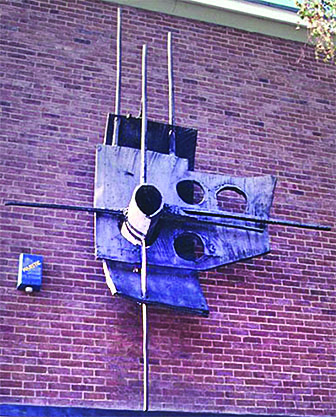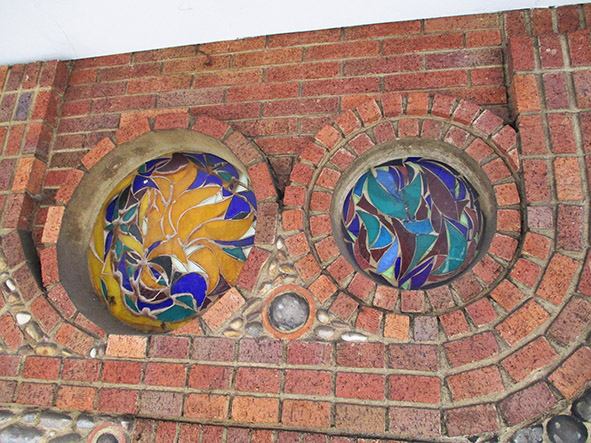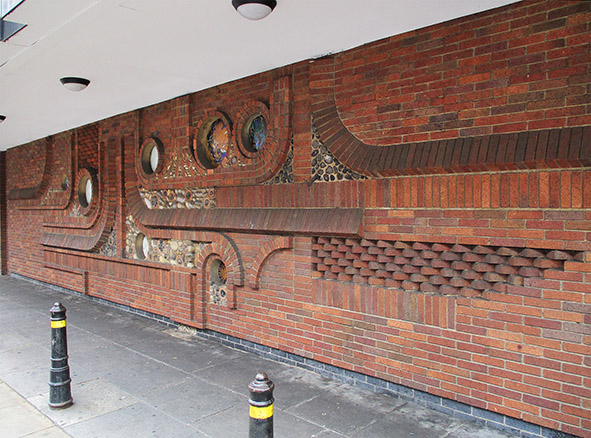- Screen Colours:
- Normal
- Black & Yellow
The ‘Sor of Hing’ typo from David Saunders
The October 2020 edition of the Newsletter has an article about public art in Ipswich and mentions the Sor of Hing at St Matthews roundabout. I can throw some light on the name.For many years my father was a linotype operator working the night shift at the East Anglian Daily Times and I can remember him telling me how the Sor of Hing name came about. Several linotype machines were used to convert the hand-written or manual type-written reports into metal type that was used to make the printing plates for the printing press. The linotype operator worked at a keyboard typing in the reports. Each depression of a key on the keyboard released a small metal matrix of the required letter/number from a magazine.
 The matrix dropped down into an assembler and once a line of type had been assembled it was sent to the casting section of the machine – hence the name “lin(e)-o(f)-type”. The casting section had a pot of molten lead and produced a slug that was then used to assemble a column and ultimately a whole page of the newspaper. This is the derivation of the term “hot metal” in newspaper production. Once the slug had been made the machine returned the matrices to the magazine. The production of the slug was quite quick, only a matter of seconds, and the operator could continue typing while it was going on. It sometimes happened that if there was high use of a particular letter in the space of a short time and/or the operator was typing very quickly the machine did not have time to return enough matrices to the magazine.
The matrix dropped down into an assembler and once a line of type had been assembled it was sent to the casting section of the machine – hence the name “lin(e)-o(f)-type”. The casting section had a pot of molten lead and produced a slug that was then used to assemble a column and ultimately a whole page of the newspaper. This is the derivation of the term “hot metal” in newspaper production. Once the slug had been made the machine returned the matrices to the magazine. The production of the slug was quite quick, only a matter of seconds, and the operator could continue typing while it was going on. It sometimes happened that if there was high use of a particular letter in the space of a short time and/or the operator was typing very quickly the machine did not have time to return enough matrices to the magazine.
This was the situation when this particular item was being prepared. The operator would have pressed the letter ‘t’ on the keyboard but the magazine was temporarily out of the required matrix and nothing dropped down. The error should have been picked up either by the operator himself or the proof reader.
(As a footnote – to the best of my knowledge my father was NOT the operator involved!)
Artistic craftsmen from Margaret Hancock
Thanks for the excellent October Newsletter. I was particularly interested to see articles referring to the work of some highly skilled Ipswich people in the past – Len Smith the skilled welder at Jubys assembling Eduardo Paolozzi’s sculptures, and the highly talented team at Titchmarsh & Goodwin producing quality reproduction furniture for princes, presidents and kings.

The photograph of the Sainsbury’s mural in decorative brickwork etc on Page 11 reminded me of other tradesmen working for local building firm Cubitt & Gotts at Westerfield in the 1970s. At the time the firm employed a large workforce of apprenticeship-trained men in all building trades. They were particularly known for high quality restoration of churches and historic buildings, travelling as far afield as Somerleyton Hall near Lowestoft. Though the artist/designer of the Sainsbury’s mural is uncredited it took the considerable skill of two bricklayers to construct the wall; if my memory serves me correctly these were Dennis Mann and Ron Alcock.
The popularity of The Repair Shop programme on TV shows that practical skills are much valued even in this technological age. We are fortunate that such expertise is still taking the name of Ipswich across the world by the top quality traditional craft made by Spirit Yachts.
{SNAP!}Brickwork mural from Derek Clive Norman
Thank you for another most interesting newsletter. Having lived all my life in Ipswich each issue invariably includes some aspect of Ipswich new to me, plus information on people and places I have known during this time. The October edition on page 11 showed the relief mural on the side of Sainsburys supermarket.
At the time I worked for Cubitt & Gotts who were the main contractors for this and the C&A building, now Wilkos in the 1970s. Although not directly involved with the project, I know from contact with those who worked on the site that the mural was developed from a sketch design provided by the architects for the building, Pick, Everard, Keay & Gimson, who, if my memory serves me, were based in Leicester. The architect was unable to provide working details to the site staff but having discussed his ideas with the foreman bricklayer gave him free reign to create the mural we see today.

The bricklayer foreman was Dennis Mann and he was assisted by Ron Alcock. These two excellent tradesmen contributed to buildings in Ipswich and the surrounding area as well as helping to train many apprentices through the Cubitt's training scheme. The quality of the work is testimony to the high standards this family building business and its workforce aimed for.
[Thanks to Margaret and Derek for providing this information; the Upper Brook Street Sainsbury branch opened in 1971, so their memories are very good. Unfortunately, the Norfolk & Suffolk Public Sculpture website is now an archived project, so we can’t send details and images of the mural to them. – Ed.]
The Society's booklet Public art in Ipswich was published in January 2021 and can be downloaded from this website.